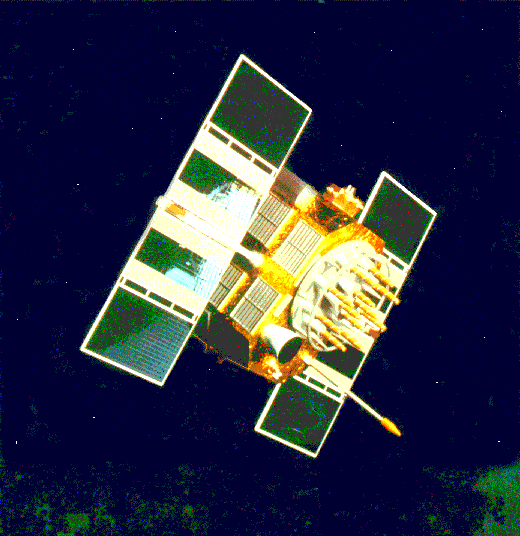 |
GPS SYSTEMS |
 |
 |
GPS SYSTEMS |
 |

The space segment of the GPS system consists of 24 operational satellites in six equally spaced orbital planes (60 degrees apart), four satellites belong to each plane. Although, there are often more than 24 operational satellites as new satellites are launched to replace older ones. The satellites operate in circular 12,552 mile orbits, that take 12 hours, at an inclination angle of 55 degrees(in respect to the equatorial plane). The position is therefore the same each day in relation to the rotation of the Earth, i.e. the satellites appear 4 minutes earlier each day. This constellation provides the user with between five and eight satellites visible from any point on the earth at anytime.
The satellites are powered by solar energy. They have backup batteries onboard to keep them running in the event of a solar eclipse, when there's no solar power. Small rocket boosters on each satellite keep them flying in the correct path. Each of these 2,000-4,000-pound solar-powered satellites travel roughly at 7,000 miles an hour and measure 17 feet accross with solar panels extended. The solar power is used to power the rockets and the transmitter, which is powered by nothing greater than 50 watts.
The current constellation consists of 29 Block II/IIA/IIR satellites. All launches have been successful except for one launch failure in 1981. The full 24-satellite constellation was completed on March 9, 1994.
The first eleven spacecraft (Block I) were used to demonstrate the feasibility of the GPS system. They were launched in 1978. The orbit inclination used for these satellites was 63 degrees, differing from the 55 degrees used in the current system. Block I are referred to as the original concept validation satellites developed by Rockwell International.


The Block II satellites, space vehicle numbers 13 through 21, are the first full scale operational satellites developed by Rockwell International. Block II satellites were designed to provide 14 days of operation without contact from the Control Segment. The Block IIs were launched from February 1989 through October 1990.
The Block IIA spacecraft (A = Advanced) were a slight improvement over the Block II, 22 through 40, are the second series of operational satellites, also developed by Rockwell International. Block IIA satellites were designed to provide 180 days of operation without contact from the Control Segment. The Block IIAs were launched November 1990 through November 1997.
The design life of the Block II/IIA satellite is 7.3 years. Each satellite contains four atomic clocks; two Cesium and two Rubidium. They also have the Selective Availabity and Anti-Spoof capabilities. The Block II/IIA satellites were launched from Cape Canaveral Air Force Station, Florida.
 The Block IIR satellites, 41 through 62, are the operational replenishment satellites developed by Lockheed Martin and will carry the GPS well into the next century. Block IIR satellites are designed to provide at least 14 days of operation without contact from the Control segment and up to 180 days of operation when operating in the autonomous navigation mode. Full accuracy will be maintained using a technique of ranging and communication between the Block IIR satellites. The cross-link ranging will be used to estimate and update the parameters in the navigation message of each Block IIR satellite without contact from the Control segment. The design life of the Block IIR satellite is 7.8 years; each contains three Rubidium atomic clocks and have the
Selective Availabity and Anti-Spoof capabilities. Launching of the Block IIRs began in January 1997, and the most recent was launched in March of 2004.
The Block IIR satellites, 41 through 62, are the operational replenishment satellites developed by Lockheed Martin and will carry the GPS well into the next century. Block IIR satellites are designed to provide at least 14 days of operation without contact from the Control segment and up to 180 days of operation when operating in the autonomous navigation mode. Full accuracy will be maintained using a technique of ranging and communication between the Block IIR satellites. The cross-link ranging will be used to estimate and update the parameters in the navigation message of each Block IIR satellite without contact from the Control segment. The design life of the Block IIR satellite is 7.8 years; each contains three Rubidium atomic clocks and have the
Selective Availabity and Anti-Spoof capabilities. Launching of the Block IIRs began in January 1997, and the most recent was launched in March of 2004.
Top of Page --
Home--
GPS --
Accuracy --
GPS Satellite System
The Satellite Signal --
Sources of Signal Problems --
Printable Summary
Experimentation and Results --
Who We Are --
Project Sources